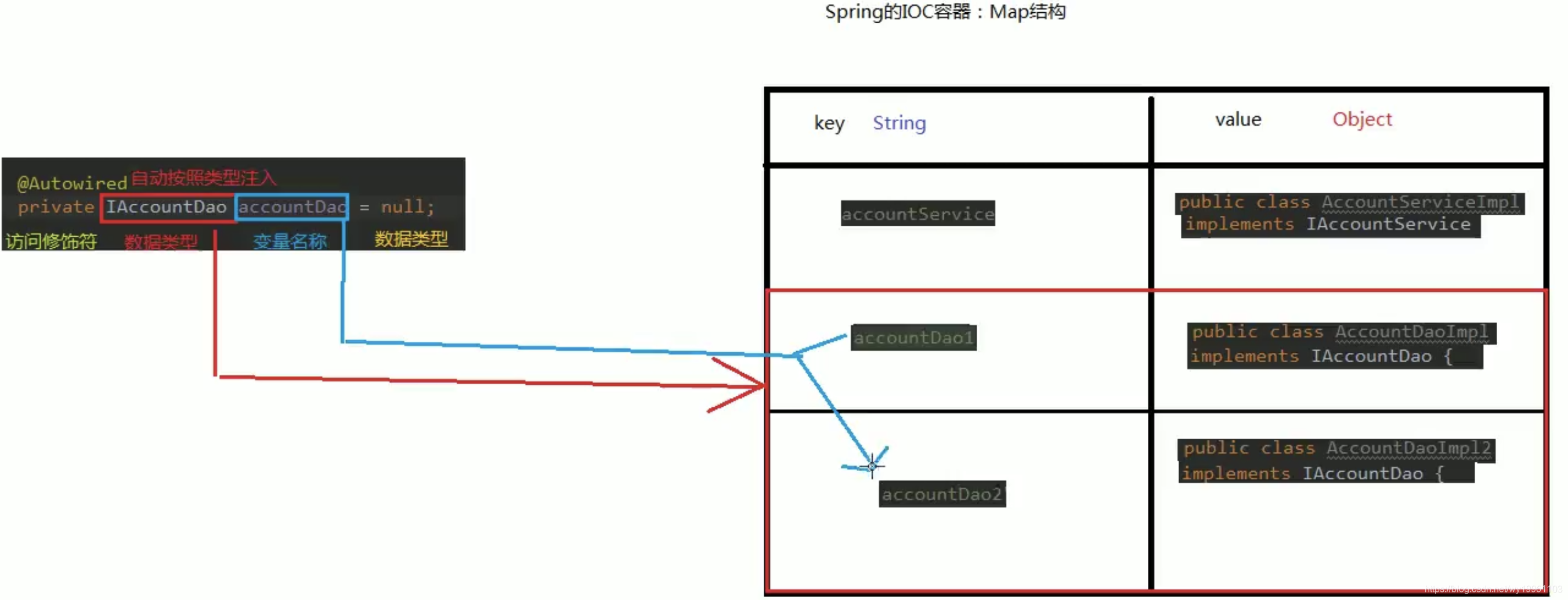Spring基于注解的IOC以及IOC的案例
1.Spring中IOC的常用注解
2.案例使用xml方式和注解方式实现单表的CRUD操作
持久层技术选择:dbutils
3.改造基于注解的IOC案例,使用纯注解的方式实现
spring的一些新注解使用
4.spring和Junit的整合
<bean id="accountService" class="com.itheima.service.impl.AccountServiceImpl"
scope="",init-method="" destory-method="">
<propety>name="",value="",ref=""</propety>
</bean>
一、注解创建对象
- 用于创建对象:
他们的作用就和在XML配置文件中编写一个<bean>标签实现的功能是一样的
Component:
作用:用于把当前类对象存入spring容器中
属性:
value:用于指定bean的id。当我们不写时,它的默认值是当前类名,且首字母改小写。
Controller:一般用在表现层
Service:一般用在业务层
Repository:一般用在持久层
以上三个注解他们的作用和属性与Component是一模一样。
他们三个是spring框架为我们提供明确的三层使用的注解,使我们的三层对象更加清晰
bean.xml:需要context
<?xml version="1.0" encoding="UTF-8"?>
<beans xmlns="http://www.springframework.org/schema/beans"
xmlns:xsi="http://www.w3.org/2001/XMLSchema-instance"
xmlns:context="http://www.springframework.org/schema/context"
xsi:schemaLocation="http://www.springframework.org/schema/beans
http://www.springframework.org/schema/beans/spring-beans.xsd
http://www.springframework.org/schema/context
http://www.springframework.org/schema/context/spring-context.xsd">
<!--告知spring在创建容器时要扫描的包,配置所需的标签不是在beans的约束中,
而是一个名称为context名称空间和约束中-->
<context:component-scan base-package="com.itheima."></context:component-scan>
</beans>
@Component("accountService")//可以不写
public class AccountServiceImpl implements IAccountService {
private IAccountDao accountDao ;
public AccountServiceImpl(){
System.out.println("对象创建了");
}
public void saveAccount(){
accountDao.saveAccount();
}
}
public static void main(String[] args) {
//1.获取核心容器对象
ApplicationContext ac = new ClassPathXmlApplicationContext("bean.xml");
// ApplicationContext ac = new FileSystemXmlApplicationContext("C:\\Users\\zhy\\Desktop\\bean.xml");
//2.根据id获取Bean对象
IAccountService as = (IAccountService)ac.getBean("accountService");

二、用于注入数据的
他们的作用就和在xml配置文件中的bean标签中写一个<property>标签的作用是一样的
Autowired:
作用:自动按照类型注入。只要容器中有唯一的一个bean对象类型和要注入的变量类型匹配,就可以注入成功
如果ioc容器中没有任何bean的类型和要注入的变量类型匹配,则报错。
如果Ioc容器中有多个类型匹配时:数据类型先匹配,再配
出现位置:
可以是变量上,也可以是方法上
细节:
在使用注解注入时,set方法就不是必须的了。

Qualifier:
作用:在按照类中注入的基础之上再按照名称注入。它在给类成员注入时不能单独使用。但是在给方法参数注入时可以(稍后我们讲)
属性:
value:用于指定注入bean的id。
Resource
作用:直接按照bean的id注入。它可以独立使用
属性:
name:用于指定bean的id。
以上三个注入都只能注入其他bean类型的数据,而基本类型和String类型无法使用上述注解实现。
另外,集合类型的注入只能通过XML来实现。
Value
作用:用于注入基本类型和String类型的数据
属性:
value:用于指定数据的值。它可以使用spring中SpEL(也就是spring的el表达式)
SpEL的写法:${表达式}
@Component("accountService")
public class AccountServiceImpl implements IAccountService {
@Autowired
private IAccountDao accountDao ;
public AccountServiceImpl(){
System.out.println("对象创建了");
}
public void saveAccount(){
accountDao.saveAccount();
}
}
三、用于改变作用范围的
他们的作用就和在bean标签中使用scope属性实现的功能是一样的
Scope
作用:用于指定bean的作用范围
属性:
value:指定范围的取值。常用取值:singleton prototype
四.生命周期
